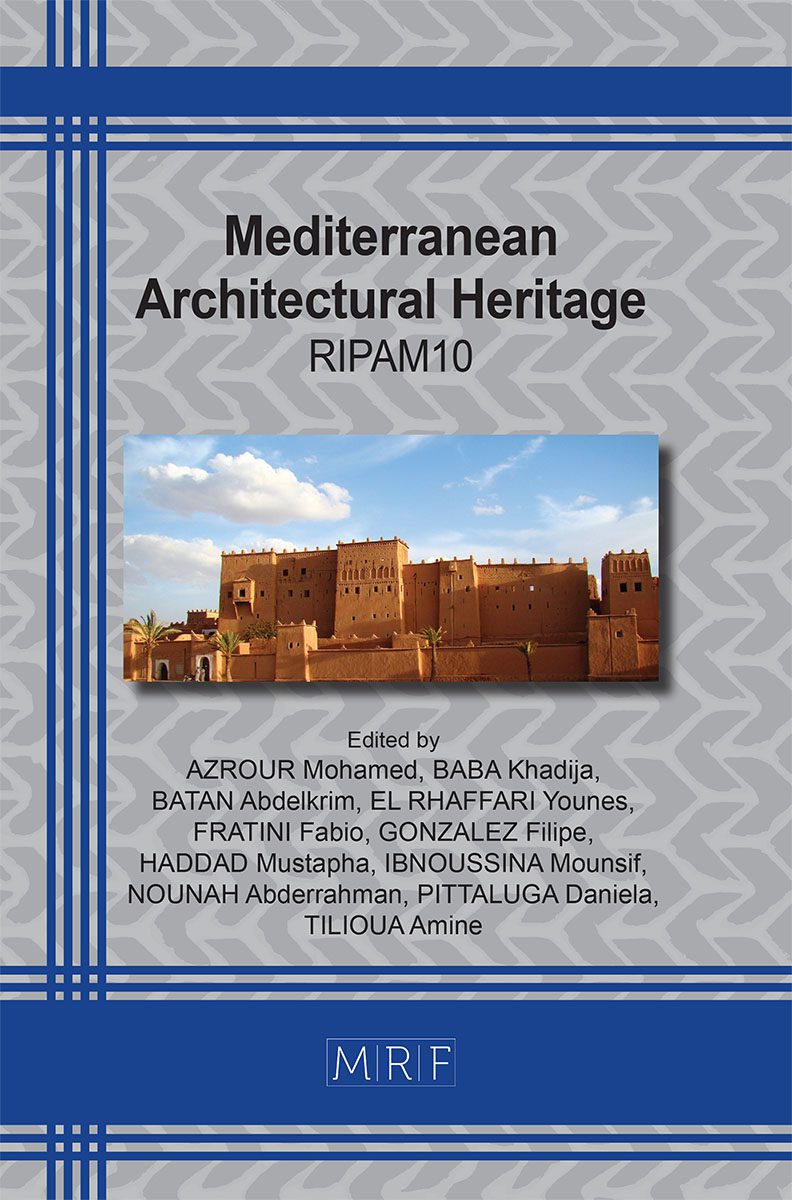Geopolymers: An Eco-Friendly Approach to Enhancing the Stability of Earthen Constructions
Ilham MASROUR, Khadija BABA, Khaoula DOUGHMI
download PDFAbstract. Earthen constructions, characterized by their historical longevity and adaptability to various environments, constitute an essential part of the global architectural heritage. These structures offer environmental advantages by utilizing local resources, but they also face challenges such as weather sensitivity, vulnerability to earthquakes, and degradation over time. Preserving these constructions while meeting modern sustainability standards poses a crucial challenge. In this context, geopolymers emerge as innovative solutions for stabilizing earthen constructions. A sustainable alternative is provided by geopolymers, which are composed of fly ash and ground granulated blast furnace slag to enhance soil cohesion and strength. This review article aims to provide an insightful perspective on compression tests specific to various types of geopolymers. The objective is to guide the choice of the method for stabilizing earthen constructions based on available resources.
Keywords
Earthen Constructions, Geopolymers, Compression Strength, Stabilizing Earthen Constructions
Published online 3/15/2024, 7 pages
Copyright © 2024 by the author(s)
Published under license by Materials Research Forum LLC., Millersville PA, USA
Citation: Ilham MASROUR, Khadija BABA, Khaoula DOUGHMI, Geopolymers: An Eco-Friendly Approach to Enhancing the Stability of Earthen Constructions, Materials Research Proceedings, Vol. 40, pp 226-232, 2024
DOI: https://doi.org/10.21741/9781644903117-24
The article was published as article 24 of the book Mediterranean Architectural Heritage
![]() Content from this work may be used under the terms of the Creative Commons Attribution 3.0 license. Any further distribution of this work must maintain attribution to the author(s) and the title of the work, journal citation and DOI.
Content from this work may be used under the terms of the Creative Commons Attribution 3.0 license. Any further distribution of this work must maintain attribution to the author(s) and the title of the work, journal citation and DOI.
References
[1] R.A. Silva, D.V. Oliveira, T. Miranda, N. Cristelo, M.C. Escobar, E. Soares, Rammed earth construction with granitic residual soils: The case study of northern Portugal, Constr. Build. Mater. 47 (2013) 181–191. https://doi.org/10.1016/j.conbuildmat.2013.05.047
[2] S. Samadianfard, V. Toufigh, Energy Use and Thermal Performance of Rammed-Earth Materials, J. Mater. Civ. Eng. 32 (2020) 04020276. https://doi.org/10.1061/(ASCE)MT.1943-5533.0003364
[3] E. Hany, N. Fouad, M. Abdel-Wahab, E. Sadek, Investigating the mechanical and thermal properties of compressed earth bricks made by eco-friendly stabilization materials as partial or full replacement of cement, Constr. Build. Mater. 281 (2021) 122535. https://doi.org/10.1016/j.conbuildmat.2021.122535
[4] D. Nigitha, N. Prabhanjan, Efficiency of cement and lime in stabilizing the black cotton soil, Mater. Today Proc. 68 (2022) 1588–1593. https://doi.org/10.1016/j.matpr.2022.07.286.
[5] A.A. Disu, P.K. Kolay, A Critical Appraisal of Soil Stabilization Using Geopolymers: The Past, Present and Future, Int. J. Geosynth. Ground Eng. 7 (2021) 23. https://doi.org/10.1007/s40891-021-00267-w
[6] J. Davidovits, GEOPOLYMER Chemistry & Applications, 2ème édition, Institut géopolymère, 2008.
[7] Z. Zhang, H. Yu, M. Xu, X. Cui, Preparation, characterization and application of geopolymer-based tubular inorganic membrane, Appl. Clay Sci. 203 (2021) 106001. https://doi.org/10.1016/j.clay.2021.106001
[8] H.M. Giasuddin, J.G. Sanjayan, P.G. Ranjith, Strength of geopolymer cured in saline water in ambient conditions, Fuel 107 (2013) 34–39. https://doi.org/10.1016/j.fuel.2013.01.035.
[9] J.E. Oh, P.J.M. Monteiro, S.S. Jun, S. Choi, S.M. Clark, The evolution of strength and crystalline phases for alkali-activated ground blast furnace slag and fly ash-based geopolymers, Cem. Concr. Res. 40 (2010) 189–196. https://doi.org/10.1016/j.cemconres.2009.10.010.
[10] S. Aydın, B. Baradan, Mechanical and microstructural properties of heat cured alkali-activated slag mortars, Mater. Des. 35 (2012) 374–383. https://doi.org/10.1016/j.matdes.2011.10.005
[11] M.O. Yusuf, M.A. Megat Johari, Z.A. Ahmad, M. Maslehuddin, Influence of curing methods and concentration of NaOH on strength of the synthesized alkaline activated ground slag-ultrafine palm oil fuel ash mortar/concrete, Constr. Build. Mater. 66 (2014) 541–548. https://doi.org/10.1016/j.conbuildmat.2014.05.037
[12] E. Hany, N. Fouad, M. Abdel-Wahab, E. Sadek, Compressive strength of mortars incorporating alkali-activated materials as partial or full replacement of cement, Constr. Build. Mater. 261 (2020) 120518. https://doi.org/10.1016/j.conbuildmat.2020.120518.
[13] J. Aliques-Granero, M.T. Tognonvi, A. Tagnit-Hamou, Durability study of AAMs: Sulfate attack resistance, Constr. Build. Mater. 229 (2019) 117100. https://doi.org/10.1016/j.conbuildmat.2019.117100
[14] M. Vafaei, A. Allahverdi, P. Dong, N. Bassim, Acid attack on geopolymer cement mortar based on waste-glass powder and calcium aluminate cement at mild concentration, Constr. Build. Mater. 193 (2018) 363–372. https://doi.org/10.1016/j.conbuildmat.2018.10.203.
[15] R.K. Preethi, B.V. Venkatarama Reddy, Experimental investigations on geopolymer stabilised compressed earth products, Constr. Build. Mater. 257 (2020) 119563. https://doi.org/10.1016/j.conbuildmat.2020.119563
[16] M. Zamanian, M. Salimi, M. Payan, A. Noorzad, M. Hassanvandian, Development of high-strength rammed earth walls with alkali-activated ground granulated blast furnace slag (GGBFS) and waste tire textile fiber (WTTF) as a step towards low-carbon building materials, Constr. Build. Mater. 394 (2023) 132180. https://doi.org/10.1016/j.conbuildmat.2023.132180.
[17] N. Vivek A, P. Kumar P, H. Reddy M, Mineral Katkılarla Stabilize Edilmiş Sıkıştırılmış Toprağın Uzun Vadeli Dayanımı ve Performansı Üzerine Deneysel Çalışma, El-Cezeri Fen Ve Mühendis. Derg. (2022). https://doi.org/10.31202/ecjse.1094013
[18] R.A. Tchouateu Kamwa, S. Tome, J. Chongouang, I. Eguekeng, A. Spieß, M.N.A. Fetzer, K. Elie, C. Janiak, M.-A. Etoh, Stabilization of compressed earth blocks (CEB) by pozzolana based phosphate geopolymer binder: Physico-mechanical and microstructural investigations, Clean. Mater. 4 (2022) 100062. https://doi.org/10.1016/j.clema.2022.100062
[19] Reactivity of volcanic ash in alkaline medium, microstructural and strength characteristics of resulting geopolymers under different synthesis conditions | Journal of Materials Science, (n.d.). https://link.springer.com/article/10.1007/s10853-016-0257-1 (accessed February 4, 2024).












